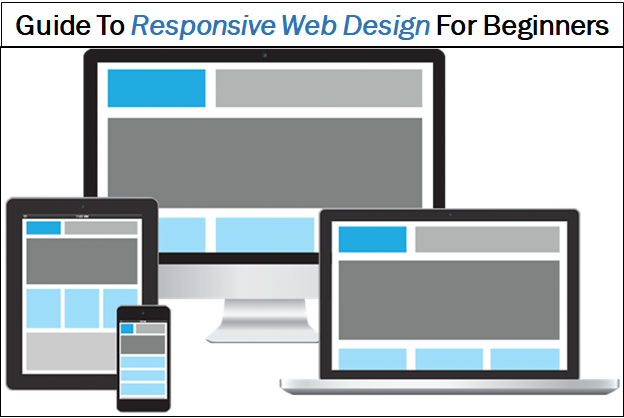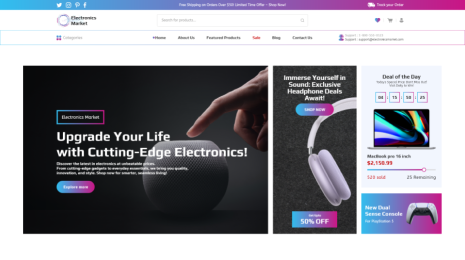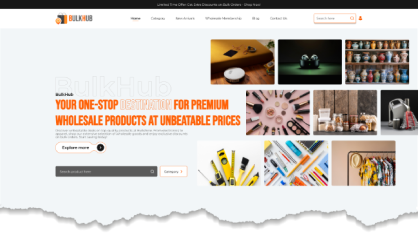
The modern web design method, known as responsive website design, illustrates the need for the overall design and construction to satisfy the behavior and set of users depending on the orientation, platform, and screen dimensions.
It amalgamates layouts, grids, images, and CSS media queries. Websites with the such ability enable users to switch seamlessly between different platforms of varying sizes and resolutions. It allows images and text to accommodate flawlessly.
An ideal responsive website must automatically react to what the user prefers. As a result, discarding the dependence on creating multiple designs and opting for a range of development steps to cater to every available device.
Although it is a great approach, there are still a few fundamental principles to give the users the best experience.
Benefits of Responsive Website Design
The idea of responsive designs is to create websites that can easily adjust to your user’s viewport size. Delivering a flawless experience is the goal of this approach regardless of which device users use to visit the website.
Primarily, the advantage of using a responsive website design is to offer users a fast-loading website that does not distort and requires users to make manual adjustments to read the content.
In this section, we offer you a range of other benefits that responsive web designs provide businesses, designers, and users.
Improved User Experience
It gets aggravating when you open a website on your mobile device, and instead of being able to read or view the content flawlessly, you are busy adjusting the content. Sometimes the content is cut off, while other times website design component covers the content.
The instant reaction of a user is to leave the website and find a platform that caters to their device. Therefore, if you want to improve your visitor experience, delivering content optimized for mobile devices is ideal.
A responsive design for your site will eventually make your content readable and hold your customer on the website for extended periods. Moreover, if users appreciate your site, they will actively interact with it and even boost sales.
Hence, a good design will positively influence businesses and facilitate user experience.
Mobile Compatibility
Every individual owns a mobile device. And they are using these devices all the time. Whether they are home, traveling, working, or spending time with friends. Additionally, with the internet being easily accessible, they are connected 24/7, even when moving.
As a consequence, browsing with mobile devices has become quite common. Moreover, certain users even search for similar content using a separate device. Meanwhile, mobile phones are the only medium for specific users to surf the net.
Therefore, it becomes essential to create websites optimized for different mobile devices. Using responsive web design, you can ensure the users get the best experience on every device. Prioritizing the users ensures users achieve an intuitive browsing experience.
Improved SEO
The success of your website relies on a list of factors. SEO (Search Engine Optimization) is crucial in helping your website grow. Since a maximum of online search traffic goes to the top first page websites, it becomes a battle to stay on top. SEO strategies aid in helping websites sustain or reach these positions.
A responsive website design works equally as high-quality content for boosting your website SEO. Search engines love websites that cater to mobile devices giving your website an added advantage. Thus, a responsive website will rank higher on search engines and attract more users.
Further, it is ideal to have one website optimized for mobile devices instead of using a variety of versions for mobile devices and desktops. It also helps prevent the problem of duplicating the content, which adversely affects the search rankings.
Increased Conversion Rates
For those thinking reducing the bounce rate of your website is complex, the real challenge is maintaining consistency when users access your website via various devices. Doing so will result in converting fresh clients.
No user desires to be redirected to a website catering to a specific device when registering for your services. If so, the process can consume a lot of their time. When you have a single website for all devices, it makes your website appear more professional.
Additionally, users will complete the process without getting annoyed and not choose your competition instead. Hence, a responsive web design is critical to increasing conversions.
Time and Cost Savings
Building individual websites for mobile devices and the desktop can be time-consuming if you think practically. Therefore, building a single responsive website that caters to all devices is best. Moreover, time equals money, and choosing a responsive website design costs much less.
Additionally, the cost of a responsive website seems more than creating different sites for different devices. However, eventually, it allows you to save on the cost of unique configuration, maintenance, and more because you only have a single website and not different versions of websites.
How to Make Website Responsive
Multiple users say no to businesses that have websites with poor mobile designs. This is understandable, with over fifty percent of the website traffic being mobile users. Hence, it is essential to optimize websites.
To create mobile-friendly devices, you must apply responsive web design. Therefore to make your website responsive, you can incorporate the given points.
Start With a Mobile-First Approach
In the mobile-first approach, web designers first create the design while keeping mobile devices in mind. They will sketch or create a prototype of the design for the tiniest screen and then gradually increase the size.
Starting with a mobile design ensures that each element is visible to the user, even with limited space. First, designing for mobile screens obliges designers to do away with unnecessary elements to ensure impeccable navigation.
When creating a website for mobile users, assess what they want, and design the page accordingly. As you move on with the size, you can smartly add the elements for functionality.
Use Responsive Frameworks and Grids
Earlier, the base of websites was pixel measurements. Today, websites use a fluid grid. The purpose of a fluid grid is to place and establish each web design element on a website so that it corresponds to the screen size it will be visible.
The fluid grid’s web elements react and scale up or down based on the screen size. This was not the case earlier, where elements were made in one specific dimension in pixels. A fluid grid splits into columns with scalable breadth and height.
Their dimensions are flexible with text and elements proportions depending on how small or large a screen is. Using a fluid grid allows websites to display content consistently on all devices. You will have more power over content alignment and speed up the design decision-making process.
Use Responsive Images and Videos
Ideally, along with a responsive design, it is also essential to make your visual elements responsive. As a result, users can view your content effectively on various devices.
For creating responsive images, you must employ tag attributes for images. The code enables the adjustability of images corresponding to the container's width. Some tags combine to ensure the rendering of a single image and enable it to fit flawlessly on the visitor's device. There are other code tags, including for notifying the search engines and lazy loading.
It would help if you employed an aspect ratio to create responsive videos for your website. The coding will help you ensure flexibility with an aspect ratio of 16:9.
Utilize CSS Media Queries
Besides using responsive videos and images, media queries are common in responsive designs. Media queries are an essential part of CSS3 and enable you to quickly create content that can adapt to screen resolutions and sizes.
It allows you to establish unique designs for distinct sizes of web browsers. Additionally, same as if clause of specific coding languages, it determined the dimension of the viewport before carrying out a suitable code.
The CSS3 media queries are compatible with different media types, including screen, handhelds, and print. It also offers refreshing media features such as orientation, color, device width, and max-width.
Test and Optimize for Different Devices
When trying to make a responsive website, testing your website on real devices is imperative. Although developers can alter the coding to their wish, testing and verifying the website's functionality is necessary when it meets the real users' demands.
You must check how the website displays on all kinds of devices. Testing your website design on genuine devices is essential to understand what your website users will view. You can use a checker for responsive design after finishing coding. You may enter your site's address to check how well it works on different websites.
Responsive Website Design Best Practices
Whether you are starting a new website or recreating the web design, here are a few of the best responsive website design practices to ensure your site looks excellent on every device. You can include the following practices to optimize your site.
Keep It Simple
Aim for simplicity. Your website’s appearance plays a significant role. The best practice of a responsive website design is to incorporate a minimalistic design that won't slow your website. A clean and not overcrowded design helps retain users and increase website engagement.
Moreover, when creating a website for smaller screen devices, you must include only those elements that are of utmost priority and necessary for a seamless user experience. You would not want to overwhelm your users by trying to place everything on the page.
Additionally, this also includes having simple navigation. You can stick to simple shapes for CTAs and simple designs. This practice will allow you to create a mobile-friendly site.
Optimize Images and Media
Users love a website that loads efficiently on every device. It is also essential for boosting SEO, lowering bounce rates, and increasing user experience. If the media takes time or causes the website to load slowly, the user will leave for a better website.
Therefore, you can optimize your website images and other media to increase your website speed. In responsive design, you must optimize your images, as when a website scales down visually, the size remains the same.
To fasten the loading pace, responsive images are a practical option. You must optimize the media to display nicely on corresponding devices.
Install Responsive WordPress Themes
Choosing a responsive Premium WordPress themes is a great way to ensure that your website is optimized for various devices and screen sizes. Responsive web design is a design approach that prioritizes the user experience across all devices, whether desktop, tablet, or mobile.
When you choose a responsive WordPress theme, you are essentially selecting a theme that is designed to adapt to different screen sizes and resolutions. This ensure your website will look great and be easy to use on any device, regardless of the size or shape of the screen.
Pay Attention to the Screens
Deciding on the bases of devices is not ideal, considering the market has a range of unique devices. Moreover, distinguishing based on classification is useless as specific devices fail to fit their said category. For example, some tablets have smaller dimensions than a phone certain TVs have a smaller screen than a desktop. Therefore, it is ideal for catering to screen sizes.
Equal Design Effort
Regardless of the screen size, every user deserves nothing but the best. Hence, put equal efforts into designing large and tiny screens. Make the most of the space using quality elements, content hierarchy, and more.
Display Full Information
It is wrong to presume that mobile users require different information than desktop users. Therefore, display the content to give mobile users complete access to help them locate the information effortlessly.
Performing Tests
Pretty designs as well fail to deliver the best performance. To fix various issues users might experience, testing the site with real users is essential. To keep your reputation and build an online presence, guarantee testing before publishing your site.
Prioritize Content
With a mobile-first approach, you can evaluate the essential elements to aid users in getting what they are looking for. You can follow the design for other versions by including secondary objectives.
You may include elements for micro-interactions, CTAs, etc., to help achieve the goals. It would help if you only involved the user's primary goals to avoid friction that may obstruct achieving these objectives.
You can verify the visual hierarchy and employ progressive disclosure so as not to overwhelm your visitors with too much information. You can use the navigation to deliver the primary items.
Ensure Fast Load Times
Faster website loading speed is the need of the hour. With search engines prioritizing site speed as an essential ranking factor, it is pivotal to ensure a faster website. For this purpose, you can incorporate responsive images and videos into your website.
Other than optimizing the media, you can improve your website's loading speed by lazy loading them. You can allow content to load when the user scrolls or choose the media to load after downloading content and layout. Lazy loading helps improve a website's performance.
Test and Optimize Regularly
Once the website design is done, it is time to test its usability before making it available to the public. Doing so will allow you to ensure the website work effectively for users. You must also ensure the navigation is user-friendly, straightforward, and seamless.
Testing and optimizing your website from time to time helps keep your website updated and deliver the best user experience.
Conclusion
The way every individual experience internet surfing is entirely different from yesteryears. Whenever a person wants to search the internet, their first instinct is to reach out to their mobile phones or other portable devices. Thus, the maximum traffic on most websites is via mobile devices.
Therefore, creating a website that adjusts seamlessly on all devices and delivers a consistent browsing experience becomes vital. For this purpose, you must take the responsive website design approach to create a single website that easily adjusts to every device's size and resolution.
Responsive designs bring a range of benefits. They help improve the user's experience and ensure your website is compatible with all mobile devices. It also facilitates SEO, increases conversion, and saves time and money.
In conclusion, having a responsive design for your site is pivotal for your website’s success. If you want your website to be visible online and grow your business, you must make your site responsive.








